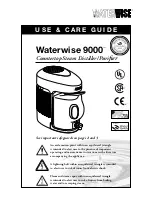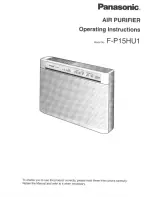
Optional Polymer Energy Wheel
Start-Up
If selected, the energy wheel is installed in the unit’s
airstream with one half of the wheel in the intake
airstream and one half in the exhaust airstream. Air
leakage between the two airstreams has to be kept to
a minimum and the wheel has air seals that must be
adjusted for that purpose. The seals must be adjusted
at time of start-up.
Sequence of Operation
Optional Economizer
- The economizer will be locked
out when: the outside air is below economizer lockout;
the unit is operating in dehumidification mode; or there
is a call for heating.
•
Stop Wheel:
When economizer mode is enabled
and there is a signal for cooling, the wheel will stop
rotating to allow free cooling.
•
Modulate Wheel:
When economizer mode is
Drive Belt
enabled and there is a signal for cooling, the wheel
VFD modulates wheel speed to maintain the
discharge temperature set point.
Optional Frost Control
- The microprocessor controller
will output a signal when wheel frosting is occurring which
is determined by a temperature set point (OA
<5°F
– 2°F hysteresis, adjustable) and wheel pressure
drop increase.
•
Preheat:
When frosting is occurring, the preheater
is energized to defrost the wheel. Once the
pressure drop decreases below the set point, the
preheater is de-energized.
•
Modulating Wheel:
Includes a VFD in addition
to the thermostat and pressure sensor. When
modulating wheel frost control is initiated, the VFD
will reduce the speed of the wheel, which keeps
Inspect the drive belt. Make sure the belt rides smoothly
in the pulley and around the outside of the wheel. Note
the directional arrow and data information shown in the
image.
Adjust the Air Seals
(Polymer wheel only)
Make sure the unit power supply is locked out.
Disconnect the wiring to the wheel module and pull the
wheel cassette out of the cabinet on its tracks. Large
cassettes are not removable. Then slowly rotate the
wheel by hand to make sure there is no binding or
misalignment.
There is a perimeter seal located around the outside of
the wheel and a diameter seal across the face of the
wheel on both sides. Check to make sure that all air
seals are secure and in good condition.
Adjust the air seals by loosening all the air seal retaining
screws on the bearing support. Using a piece of paper
as a feeler gauge, adjust the seals so they almost touch
the face of the wheel while tugging slightly on the paper.
When the wheel is rotated, there should be a slight tug
on the paper. Tighten the screws, repeat the steps on
the other set of seals.
Push the wheel cassette back into the unit and plug
in the power connector. Turn the main power supply
back on and then observe the operation of the wheel by
opening the wheel access door slightly. Remove filters if
necessary to observe the wheel.
the exhaust air condition from reaching saturation,
thus, eliminating condensation and frosting. If the
outdoor air temperature is greater than the frost
threshold temperature OR the pressure differential
is less than the set point, the wheel will run at
full speed. If the outdoor air temperature is less
than the frost threshold temperature AND the
pressure differential is greater than the set point,
the wheel will run at reduced speed until the
pressure differential falls below the set point. The
temperature and pressure differential set points are
set at the factory, but are field-adjustable. The VFD
will be fully programmed at the factory.
Timed Exhaust
: When frosting is occurring, the
supply blower is cycled off. The exhaust blower shall
continue to run, allowing the warm exhaust air to
defrost the wheel. After the 5 minute cycle, the
supply fan is re-energized to continue normal
operation.
Summary of Contents for AR-DE12-05A
Page 75: ...Gas Supply In Typical Split Burner Manifold ...
Page 94: ...NOTE For HMA gas furnace for 311 and 352 chassis see separate IOM Manual ...
Page 96: ...HANDHELD KEYPAD DISPLAY OPTIONAL ...
Page 105: ......
Page 107: ......
Page 108: ......
Page 109: ......
Page 110: ......
Page 111: ......
Page 112: ......
Page 113: ......
Page 114: ......
Page 115: ......
Page 116: ......
Page 117: ......
Page 118: ......
Page 119: ......
Page 120: ......
Page 121: ......
Page 122: ......
Page 123: ......
Page 124: ......
Page 125: ......
Page 126: ......
Page 127: ......
Page 128: ......
Page 129: ......
Page 130: ...Controls Sequence of Operation ...
Page 131: ......
Page 132: ......
Page 133: ......
Page 134: ......
Page 135: ......
Page 136: ......
Page 137: ......
Page 138: ......
Page 139: ......
Page 140: ......
Page 141: ......
Page 142: ......
Page 143: ......
Page 144: ......
Page 145: ......
Page 146: ......
Page 147: ......
Page 148: ......
Page 149: ......
Page 150: ......
Page 151: ......
Page 152: ......
Page 153: ......
Page 154: ......
Page 155: ......
Page 156: ......
Page 157: ......
Page 158: ......
Page 159: ......
Page 160: ......
Page 161: ......
Page 162: ......
Page 163: ......
Page 164: ......
Page 165: ......
Page 166: ......
Page 167: ......
Page 168: ......
Page 169: ......
Page 170: ......
Page 171: ......
Page 172: ......
Page 173: ......
Page 174: ......
Page 175: ......
Page 176: ......
















































